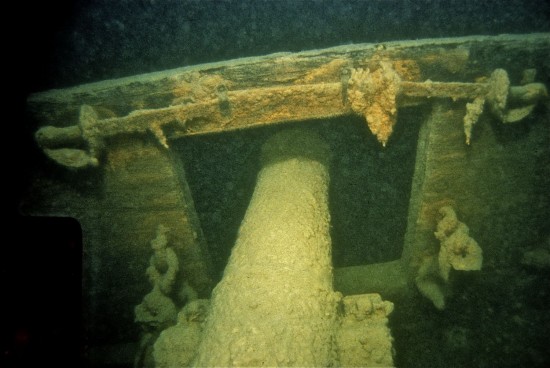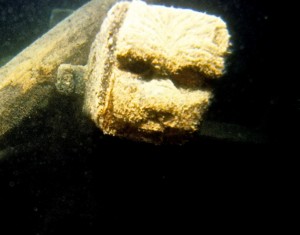Starting out as a calm night, the weather suddenly erupts into a violent squall sending the United States Navy warships USS Hamilton and USS Scourge, along with 53 sailors, to their watery graves in the cold, dark waters of Lake Ontario during the early morning hours of August 8, 1813.
Top heavy with cannons the Hamilton and Scourge quickly take on water, capsize and sink settling upright and intact 88 metres below the surface. The wrecks can’t be more perfect with cannons and crossed cutlasses visible on their decks over 160 years after their discovery. It is what every child imagines a shipwreck looks like, when in reality ship wrecks from this era usually consist of a portion of the keel, several ribs and some hull planking with none of their decks or hold contents to be found without excavation, making the Hamilton and Scourge unique world-heritage wonders in the realm of marine archaeology.
Found in 1973 by Dr. Daniel Nelson, a St. Catherines, Ontario dentist and confirmed in 1975, the Hamilton and Scourge have attracted undersea greats such as Jacques Cousteau (1980), Emory Kristof (1982) and Robert Ballard (1990), with additional expeditions in 2007, 2008 and 2009.
Earlier this year, on June 20, I was part of a Parks Canada expedition to the Hamilton and Scourge. Resting in Canadian waters, the two ships became a National Historic Site of Canada in 1976 and have been owned and managed by the City of Hamilton since 1980. Departing from Ontario’s historic Port Dalhousie on the Parks Canada research vessel Investigator, ours would be the first expedition to use a magnetometer to gather data from the wreck site.
On board the Investigator are Parks Canada employees Chriss Ludin (at the helm), Jonathan Moore and Ryan Harris, both senior marine archaeologists. Jonathan oversees the Hamilton and Scourge survey, while Ryan heads up the search for Franklin’s lost ships in the Canadian Arctic. Another member of our team is Peter Rowe, recently published author of the vastly entertaining book “Adventures in Filmmaking”. As the book’s title alludes to, Peter is a filmmaker who is producing and directing a film about Canadian-born, turned American navy sailor, Ned Myers, who survived the sinking of the Scourge. The film will be entitled “Shipwrecked on a Great Lake”.
Unfortunately, over the past couple of decades, quagga mussels, an invasive species of mussel from Europe, were introduced to the Great Lakes by foreign ships pumping their bilge water containing the mussels into the lakes. Quagga mussels now cover the lakebed around the two ships and as our side scan sonar (which we also used in addition to the magnetometer) showed the starboard side of Scourge is engulfed by quaggas obstructing the view of the hull, deck, cannons and other ship’s artifacts.
Quagga mussels will eventually encrust both vessels hiding them from clear view; fortunately the pre-quagga 1982 expedition by Emory Kristof, Chris Nicholson, Dr. Dan Nelson, Martin Bowen and Randy Weldon documented both ships.

The 1982 expedition team:
Dan Nelson, left – Randy Weldon, upper left – Emory Kristof, upper right
Chris Nicholson, right – Martin Bowen, lower center
“The 1982 expedition resulted in the largest 2,000 plus collection of the best photographs collected to date from the wrecks, as well as some colour video”, stated Jonathan Moore. “The high quality colour slides of both wrecks (first time Scourge was imaged) show in great detail the schooners as if frozen in time, a cliché that is appropriate to use in the case of these wrecks. They were used extensively for several sets of archaeological site plans created by researchers. This imagery is doubly valuable now given the subsequent colonization of the wrecks by quagga mussels, that have covered and obscured most of the features photographed in 1982. All of the 1982 slides have now been digitized.”
Quagga mussels have killed the feasibility of bringing both ships to the surface as has been done with Sweden’s Vasa and England’s Mary Rose but with all the research carried out to date it might be possible to build life-size replicas of both ships in the City of Hamilton and introduce the curious to Ned Myers.
Expeditions to the USS Hamilton and USS Scourge
All expeditions and resulting research are group efforts. Once Dr. Daniel Nelson located the Hamilton and Scourge various organizations have played, and some still do, a role in either the exploration, research, mapping, conservation, management, archiving or storytelling of these two magnificent archaeological treasures. They are, the City of Hamilton, Parks Canada, ASI Group, Canadian Conservation Institute, United States Navy, Royal Canadian Navy, Canadian Coast Guard, Canadian Hydrographic Service, Royal Ontario Museum, YAP Films and Peter Rowe Productions Inc., to name a few.
City of Hamilton website links to the USS Hamilton and USS Scourge
The Hamilton & Scourge National Historic Site
Hamilton & Scourge War Ships – War of 1812 Virtual Tour
Tourism links for Port Dalhousie and the City of Hamilton
City of Hamilton – Visitor Information
Photo Credits
All photos of the Investigator expedition are © Joseph Frey – All Rights Reserved
Photos of the Hamilton And Scourge are © Dan Nelson, Emory Kristof, Chris Nicholson,
Martin Bowen and Randy Weldon.- All Rights Reserved












Please Share Your Thoughts - Leave A Comment!